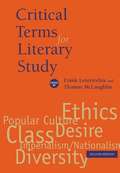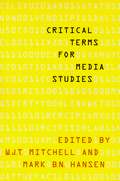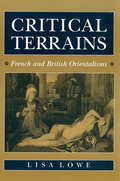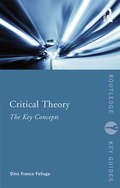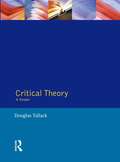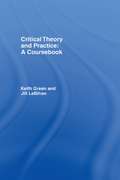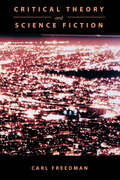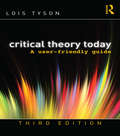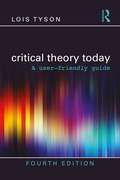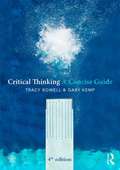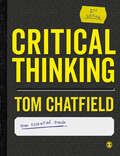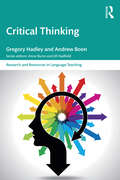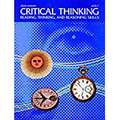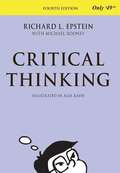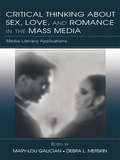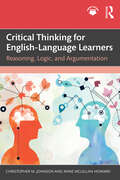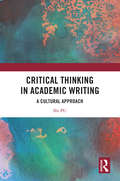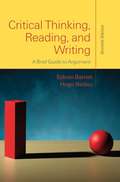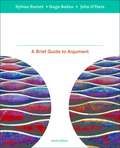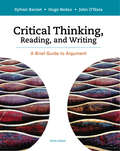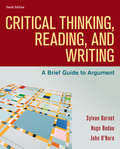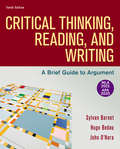- Table View
- List View
Critical Terms for Literary Study (2nd edition)
by Frank Lentricchia Thomas MclaughlinAn expanded introduction to the work of literary theory covering the concepts that shape the way we read, with 28 essays written by a plethora of distinguished scholars.
Critical Terms for Media Studies
by W. J. T. Mitchell Mark HansenCommunications, philosophy, film and video, digital culture: media studies straddles an astounding array of fields and disciplines and produces a vocabulary that is in equal parts rigorous and intuitive. Critical Terms for Media Studiesdefines, and at times, redefines, what this new and hybrid area aims to do, illuminating the key concepts behind its liveliest debates and most dynamic topics. Part of a larger conversation that engages culture, technology, and politics, this exciting collection of essays explores our most critical language for dealing with the qualities and modes of contemporary media. Edited by two outstanding scholars in the field, W.J.T. Mitchell and Mark B.N. Hansen, the volume features works by a team of distinguished contributors.
Critical Terrains: French and British Orientalisms
by Lisa LoweExamining and historicizing the concept of "otherness" in both literature and criticism, Lisa Lowe explores representations of non-European cultures in British and French writings from the eighteenth through the twentieth century. Lowe traces the intersections of culture, class, and sexuality in Lady Mary Wortley Montagu’s Turkish Embassy Letters and Montesquieu’s Lettres persanes and discusses tropes of orientalism, racialism, and romanticism in Flaubert. She then turns to debates in Anglo-American and Indian criticism on Forster’s Passage to India and on the utopian projection of China in the poststructuralist theories of Julia Kristeva and Roland Barthes and in the journal Tel Quel.
Critical Theory: The Key Concepts (Routledge Key Guides)
by Dino Franco FellugaCritical Theory: The Key Concepts introduces over 300 widely-used terms, categories and ideas drawing upon well-established approaches like new historicism, postmodernism, psychoanalysis, Marxism, and narratology as well as many new critical theories of the last twenty years such as Actor-Network Theory, Global Studies, Critical Race Theory, and Speculative Realism. This book explains the key concepts at the heart of a wide range of influential theorists from Agamben to Žižek. Entries range from concise definitions to longer more explanatory essays and include terms such as: Aesthetics Desire Dissensus Dromocracy Hegemony Ideology Intersectionality Late Capitalism Performativity Race Suture Featuring cross-referencing throughout, a substantial bibliography and index, Critical Theory: The Key Concepts is an accessible and easy-to-use guide. This book is an invaluable introduction covering a wide range of subjects for anyone who is studying or has an interest in critical theory (past and present).
Critical Theory: A Reader
by Douglas TallackAn anthology of readings and extracts providing a comprehensive introduction to the main schools and positions of critical theory. The book is divided into five sections; structuralism and poststructuralism, psychoanalytical theory, Marxism, feminism, and post-foundational ethics and politics. It includes a general introduction covering the field of critical theory and identifies founding theorists and movements with a bibliography and notes.
Critical Theory and Practice: A Coursebook
by Keith Green Jill LeBihanCritical Teory and Practice answers lots of questions, but also stimulates new ones. Its tailor-made combination of survey, reader and workbook is ideal for the beginning - perhaps even bewildered - student of literary theory. The work is divided into seven chapters, each of which contains guiding commentary, examples from literary and critical works, and a variety of exercises to provoke and engage you. Each chapter includes a glossary and annotated selection of suggested further reading. There is also a full bibliography. The authors cover the key issues and debates of literary theory, including: * Language, Linguistics and Literature * Structures of Literature * Literature and History * Subjectivity, Psychoanalysis and Criticism * Reading, Writing and Reception * Women, Literature and Criticism * Literature, Criticism and Cultural Identity Critical Theory and Practice is an refreshingly clear, up-to-date and eminently readable introduction to the subject. It not only guides you through the terminology and gives you a selection of the key passages to read, it also helps you engage with the theory and apply it in practice.
Critical Theory and Science Fiction
by Carl Freedman Carl FreedomSelected by Choice as an Outstanding Academic Book of the Year. This innovative cultural critique offers valuable insights into science fiction, thus enlarging our understanding of critical theory. Carl Freedman traces the fundamental and mostly unexamined relationships between the discourses of science fiction and critical theory, arguing that science fiction is (or ought to be) a privileged genre for critical theory. He asserts that it is no accident that the upsurge of academic interest in science fiction since the 1970s coincides with the heyday of literary theory, and that likewise science fiction is one of the most theoretically informed areas of the literary profession. Extended readings of novels by five of the most important modern science fiction authors illustrate the affinity between science fiction and critical theory, in each case concentrating on one major novel that resonates with concerns proper to critical theory. Freedman's five readings are: Solaris: Stanislaw Lem and the Structure of Cognition; The Dispossessed: Ursula LeGuin and the Ambiguities of Utopia; The Two of Them: Joanna Russ and the Violence of Gender; Stars in My Pocket Like Grains of Sand: Samuel Delany and the Dialectics of Difference; The Man in the High Castle: Philip K. Dick and the Construction of Realities.
Critical Theory Since Plato
by Hazard AdamsA collection of literary works from the Western Cannon which give insight into critical theory over the past 2000 years. There are both excerpts from primary texts and commentary. Selections come from authors including Dante, Locke, Shakespeare, Keats, and many more.
Critical Theory Today: A User-Friendly Guide
by Lois TysonThis thoroughly updated third edition of Critical Theory Today offers an accessible introduction to contemporary critical theory, providing in-depth coverage of the most common approaches to literary analysis today, including: feminism; psychoanalysis; Marxism; reader-response theory; New Criticism; structuralism and semiotics; deconstruction; new historicism and cultural criticism; lesbian, gay, and queer theory; African American criticism and postcolonial criticism. This new edition features: a major expansion of the chapter on postcolonial criticism that includes topics such as Nordicism, globalization and the 'end' of postcolonial theory, global tourism and global conservation an extended explanation of each theory, using examples from everyday life, popular culture, and literary texts a list of specific questions critics ask about literary texts an interpretation of F. Scott Fitzgerald's The Great Gatsby through the lens of each theory a list of questions for further practice to guide readers in applying each theory to different literary works updated and expanded bibliographies Both engaging and rigorous, this is a "how-to" book for undergraduate and graduate students new to critical theory and for college professors who want to broaden their repertoire of critical approaches to literature.
Critical Theory Today: A User-Friendly Guide
by Lois TysonThis thoroughly updated fourth edition of Critical Theory Today offers an accessible introduction to contemporary critical theory, providing in-depth coverage of the most common approaches to literary analysis today, including: feminism; psychoanalysis; Marxism; reader-response theory; New Criticism; structuralism and semiotics; deconstruction; new historicism and cultural criticism; lesbian, gay, and queer theory; African American criticism; and postcolonial criticism and ecocriticism. This new edition features: • A brand new chapter on ecocriticism, including sections on deep ecology, eco-Marxism, ecofeminism (including radical, Marxist, and vegetarian ecofeminisms), and postcolonial ecocriticism and environmental justice • Considerable updates to the chapters on feminist theory, African American theory, postcolonial theory, and LGBTQ theories, including terminology and theoretical concepts • An extended explanation of each theory, using examples from everyday life, popular culture, and a variety of literary texts • A list of specific questions critics ask about literary texts • An interpretation of F. Scott Fitzgerald's The Great Gatsby through the lens of each theory • A list of questions for further practice to guide readers in applying each theory to different literary works • Updated and expanded bibliographies Both engaging and rigorous, this is a "how-to" book for undergraduate and graduate students new to critical theory and for college professors who want to broaden their repertoire of critical approaches to literature.
Critical Thinking: A Concise Guide (4th Edition)
by Tracy Bowell Gary KempWe are frequently confronted with arguments. Arguments are attempts to persuade us #65533; to influence our beliefs and actions #65533; by giving us reasons to believe this or that. Critical Thinking: A Concise Guide will equip students with the concepts and techniques used in the identification, analysis and assessment of arguments. Through precise and accessible discussion, this book provides the tools to become a successful critical thinker, one who can act and believe in accordance with good reasons, and who can articulate and make explicit those reasons. Key topics discussed include: core concepts in argumentation how language can serve to obscure or conceal the real content of arguments; how to distinguish argumentation from rhetoric how to avoid common confusions surrounding words such as #65533;truth#65533;, #65533;knowledge#65533; and #65533;opinion#65533; how to identify and evaluate the most common types of argument how to distinguish good reasoning from bad in terms of deductive validly and induction. This fourth edition has been revised and updated throughout, with a new introduction for each chapter and up-to-date topical examples. Particular revisions include: practical reasoning; understanding quantitative data, statistics, and the rhetoric used about them; scientific reasoning; the connection to formal logic and the logic of probability; conditionals; ambiguity; vagueness; slippery slope arguments; and arguments by analogy. The dynamic Routledge Critical Thinking companion website provides thoroughly updated resources for both instructors and students including new examples and case studies, flashcards, sample questions, practice questions and answers, student activities and a testbank of questions for use in the classroom.
Critical Thinking: Your Guide to Effective Argument, Successful Analysis and Independent Study
by Tom ChatfieldWhat is critical thinking? How do you apply it in your assessments? How do you build a good argument or find evidence? Critical thinking is a set of techniques. You just need to learn them. This is your personal toolkit for demystifying critical thinking. Clear and focused, it shows you how to sharpen your ability to think critically by developing and honing your skills. You’ll learn how to: Build a solid argument and express your ideas clearly Evaluate evidence and identify errors Understand and account for biased or flawed thinking Become a savvy user of technology Sift through the deluge of digital information Develop confident critical writing. Designed to work with a power pack of digital resources and exercises, you′ll find practical and effective tools to think and write critically in an information-saturated age. Whether you′re starting your first degree or arriving as an international or mature student, this book equips you with the skills, insights and confidence to succeed. This second edition has been redesigned and fine-tuned with a focus on accessibility: with a new and improved layout to improve the eBook experience, and updated language, examples and further reading recommendations throughout.
Critical Thinking: Your Guide to Effective Argument, Successful Analysis and Independent Study
by Tom ChatfieldWhat is critical thinking? How do you apply it in your assessments? How do you build a good argument or find evidence? Critical thinking is a set of techniques. You just need to learn them. This is your personal toolkit for demystifying critical thinking. Clear and focused, it shows you how to sharpen your ability to think critically by developing and honing your skills. You’ll learn how to: Build a solid argument and express your ideas clearly Evaluate evidence and identify errors Understand and account for biased or flawed thinking Become a savvy user of technology Sift through the deluge of digital information Develop confident critical writing. Designed to work with a power pack of digital resources and exercises, you′ll find practical and effective tools to think and write critically in an information-saturated age. Whether you′re starting your first degree or arriving as an international or mature student, this book equips you with the skills, insights and confidence to succeed. This second edition has been redesigned and fine-tuned with a focus on accessibility: with a new and improved layout to improve the eBook experience, and updated language, examples and further reading recommendations throughout.
Critical Thinking (Research and Resources in Language Teaching)
by Gregory Hadley Andrew BoonCritical Thinking provides language teachers with a dynamic framework for encouraging critical thinking skills in explicit, systematic ways during their lessons. With the proliferation of fallacious arguments, "fake news," and untrustworthy sources in today's multimedia landscape, critical thinking skills are vital not only in one’s native language, but also when engaged in the task of language learning. Written with the language teacher in mind, this book provides a springboard for teaching critical thinking skills in multicultural, multilingual classrooms. Suitable for graduate students, in-training teachers, and language curriculum developers interested in purposeful applications of critical thinking pedagogy for the second-language classroom, this volume presents classroom activities, suggestions for lesson planning, and ideas for researching the impact of critical thinking activities with second-language learners. This book is ideal as an invaluable resource for teacher-directed classroom investigations as well as graduate dissertation projects.
Critical Thinking: Reading, Thinking, and Reasoning Skills
by Steck-VaughnTextbook to improve students' reading, thinking, and reasoning skills.
Critical Thinking, 4th Edition
by Richard L. Epstein Michael Rooney Alex RaffiWith more than 1,000 everyday examples and exercises, the text engages and challenges the student. It is the only text on critical thinking in which students work with illustrations to convert the nonverbal into arguments and arrive at conceptual understanding.
Critical Thinking About Sex, Love, and Romance in the Mass Media: Media Literacy Applications (Routledge Communication Series)
by Mary-Lou Galician Debra L. MerskinThis distinctive volume explores how romantic coupleship is represented in books, magazines, popular music, movies, television, and the Internet within entertainment, advertising, and news/information. This reader offers diverse theoretical perspectives and methodological approaches on the representation of romantic relationships across the media spectrum. Filling a void in existing media scholarship, this collection explores the media's influence on perceptions and expectations in relationships, including the myths, stereotypes, and prescriptions manifested throughout the press. Featuring fresh voices, as well as the perspectives of seasoned veterans, contributions include quantitative and qualitative studies along with cultural/critical, feminist, and descriptive analyses. This anthology has been developed for use in courses on mass media and society, media studies, and media literacy. In addition to its use in coursework, it is highly relevant for scholars, researchers, and others interested in how the media influence the personal lives of individuals.
Critical Thinking for English-Language Learners: Reasoning, Logic, and Argumentation
by Christopher M. Johnson Anne McLellan HowardCritical Thinking for English-Language Learners is an accessible introduction to critical thinking and the use of informal logic for learners of English. Critical thinking skills are key to helping students learn how to reason in English. By developing informal logic skills, students can develop their critical thinking abilities to better assess why different types of arguments are successful or unsuccessful.The textbook: introduces key concepts in critical thinking, informal logic, and argumentation; supports the development of students’ language ability by including chapter English notes which show how to express logical connections in English and give a deeper understanding of English vocabulary; provides step-by-step guidance on how to make and critique different types of arguments, and how to understand connections between ideas and their various implications; includes pre-reading questions, activities, and exercises in each chapter; is supported by a series of PowerPoint presentations, extra review exercises, and instructor resources online Providing students with key skills to make and critique arguments in English, this book is a key resource for beginning and intermediate learners of English studying Critical Thinking, English for Academic Purposes, and Introduction to Philosophy.
Critical Thinking in Academic Writing: A Cultural Approach
by Shi PuThe book inquires into critical thinking through a cultural approach. Based on an 8-month ethnographic study, it compares Chinese postgraduate students’ conceptualisations and applications of critical thinking in three different settings in China and the UK. From an insider’s perspective, it analyses the intricate interplay of multiple cultural and individual factors that conditions students’ critical thinking development as they learn to write an academic thesis and to manage postgraduate learning. The book offers insights into the nature of problems that Chinese students encounter with critical thinking and envisions possibilities for the ideas for critical thinking to have a transformative power in an intercultural space. The book will primarily be of interest to academics and educators who work on critical thinking and academic writing, especially those who work with Chinese students. Scholars interested in intercultural issues in higher education may also find it relevant.
Critical Thinking Reading and Writing: A Brief Guide to Argument (7th edition)
by Sylvan Barnet Hugo BedauCritical Thinking, Reading, and Writing is a compact but complete guide to critical thinking and argumentation. Comprising the text portion of the widely adopted Current Issues and Enduring Questions, it draws on the authors' dual expertise in effective persuasive writing and comprehensive rhetorical strategies to help students move from critical thinking to argumentative and researched writing. With comprehensive coverage of classic and contemporary approaches to argument, including Aristotle, Toulmin, and a range of alternative views, as well as 35 readings and a casebook on the state and the individual, it is an extraordinarily versatile text. This affordable guide can stand alone or supplement a larger anthology of readings.
Critical Thinking, Reading And Writing: A Brief Guide To Argument
by Sylvan Barnet Hugo Bedau John O'HaraCritical Thinking, Reading, and Writing is a compact but complete guide to critical thinking and argumentation. Comprising the text portion of the widely adopted Current Issues and Enduring Questions, it draws on the authors’ dual expertise in effective persuasive writing and comprehensive rhetorical strategies to help students move from critical thinking to argumentative and researched writing. With comprehensive coverage of classic and contemporary approaches to argument, including Aristotle, Toulmin, and a range of alternative views, as well as 35 readings and a casebook on the state and the individual, it is an extraordinarily versatile text. This affordable guide can stand alone or supplement a larger anthology of readings.
Critical Thinking, Reading, and Writing
by Sylvan Barnet Hugo Bedau John O’haraCritical Thinking, Reading, and Writing is a compact but complete guide to critical thinking and argumentation. Comprising the text portion of the widely adopted Current Issues and Enduring Questions, it draws on the authors’ dual expertise in effective persuasive writing and comprehensive rhetorical strategies to help students move from critical thinking to argumentative and researched writing. This extraordinarily versatile text includes comprehensive coverage of classic and contemporary approaches to argument, from Aristotelian to Toulmin, to a new chapter on rhetorical analysis of pop culture texts, as well as 35 readings (including e-Pages that allow students to take advantage of working with multimodal arguments on the Web), and a casebook on the state and the individual. This affordable guide can stand alone or supplement a larger anthology of readings.
Critical Thinking, Reading, and Writing: A Brief Guide To Argument
by Sylvan Barnet Hugo Bedau John O’HaraCritical Thinking, Reading, and Writing is a brief yet versatile resource for teaching argument, persuasive writing, and research. It makes argument concepts clear and gives students strategies to move from critical thinking and analysis to crafting effective arguments. Comprehensive coverage of classic and contemporary approaches to argument ― Aristotelian, Toulmin, Rogerian, visual argument, and more ― provides a foundation for nearly 50 readings on current issues, such as student loan forgiveness and gun violence, topics that students will want to engage with and debate. For today’s ever-increasingly visual learners who are challenged to separate what’s real from what’s not, new activities and visual flowcharts support information literacy, and newly annotated readings highlight important rhetorical moves. This affordable guide can stand alone or supplement a larger anthology of readings.
Critical Thinking, Reading, and Writing: A Brief Guide to Argument
by John O'Hara Sylvan Barnet Hugo BedauThis affordable resource helps you think critically and craft effective arguments.
Critical Thinking, Reading, and Writing with 2020 APA and 2021 MLA Updates: A Brief Guide to Argument
by Sylvan Barnet Hugo Bedau John O'HaraThis ebook has been updated to provide you with the latest guidance on documenting sources in MLA style and follows the guidelines set forth in the MLA Handbook, 9th edition (April 2021).Critical Thinking, Reading, and Writing is a brief yet versatile resource for teaching argument, persuasive writing, and research. It makes argument concepts clear and gives students strategies to move from critical thinking and analysis to crafting effective arguments. Comprehensive coverage of classic and contemporary approaches to argument — Aristotelian, Toulmin, Rogerian, visual argument, and more — provides a foundation for nearly 50 readings on current issues, such as student loan forgiveness and gun violence, topics that students will want to engage with and debate. For today’s ever-increasingly visual learners who are challenged to separate what’s real from what’s not, new activities and visual flowcharts support information literacy, and newly annotated readings highlight important rhetorical moves. This affordable guide can stand alone or supplement a larger anthology of readings.
